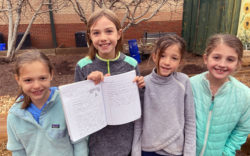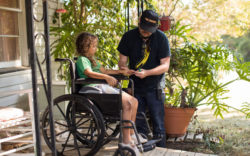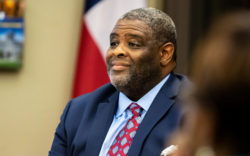There are stone sculptures, hand-built bridges and the basins of past ponds once fed by a nearby spring. The wind whispers through the trees that follow the slope of the hill down to the river. And these 100-year-old gardens surround a house built of the forest’s timbers, once used as a family getaway.
No, it’s not a spot on the Biltmore estate or tucked away in a New England town. It’s right here in Athens. And we all own it.
The question facing local officials now are: How can this property be protected from further deterioration brought on by time—and what purpose can the property serve in the future?
Known as Beech Haven, the property was the focus of two public meetings last week. On Feb. 19, UGA’s Willson Center for the Humanities and Arts brought nationally recognized author and Arts & Crafts expert Paul Duchscherer, and a second focus group event on Feb. 20 that delved into possible plans for the property. The universal theme that came from both events was clear: This property, which is hidden from the main road and without public access, is important on a national scale. And if some stabilizing isn’t done soon, some of its best features could be lost.

Photo Credit: Kristen Morales
The Rowland family home was built in 1910 from timbers cut on the property.
Located in a secluded wooded area along the Middle Oconee River north of Atlanta Highway, Beech Haven was originally 250 acres owned by the Rowland family. Over time, parcels were peeled away and either sold off or given to other family members. Athens-Clarke County, seeing the potential for a future greenway connection along the river as well as the pressure from development, began buying up the wooded area in 2009 using a combination of federal grants and local sales tax dollars earmarked for greenspace conservation.
The property is more than just native forests covering a high bluff and rolling down to the river’s shoals. A portion of the 82 acres, purchased by the county in 2012, is home to the Rowland family’s summer home. Built by Charles and Effie Rowland in 1910, the two-story home includes fireplaces made of stones brought up from the river. There even is a porch fountain, also made of stone, that was fed by a nearby spring. Outside the home, the driveway passes several stone bridges, seats, ponds and decorative stone lanterns. The house was Effie’s project; the gardens were made by Charles, who was influenced by his many travels to Asia as a Presbyterian missionary. One bridge in particular, called a “camelback” bridge because of its humped shape, was taken directly from Asian designs.
“One entrance [to the property] was a series of fish ponds and a lotus pond,” said Ron Thomas, chairman of the Oconee Rivers Greenway Commission, which hosted the Feb. 20 event at the Lyndon House Arts Center. About 50 community leaders and activists attended the event. “There are whimsical stone structures scattered around the property; there is a bench where you can dangle your feet in the water.”
The water is no longer there—development of the nearby Forest Heights neighborhood dried it up—but the network of water features isn’t lost, noted a couple ACC officials at the event, and water could be brought back to these areas.
Water plays an even more important role in the property, as it provides a link to why the country purchased it in the first place. It sits at a key point along the Middle Oconee River, linking a planned greenway trail from Atlanta Highway to points north. ACC Environmental Coordinator Andrew Saunders said at the Lyndon House meeting that the point of the county greenspace program is to protect sensitive lands, wildlife habitat and look at development patterns—and all of that pointed to purchasing this property. “What we know today—we have this land; we know we will put in a greenway connection,” he said. “And we’ve stumbled into acquiring this historic resource.” The question now, he said, “is how can the government and other county partners mobilize to protect this resource?”
The combination of a hand-hewn home that incorporates nature in its design, as well as Asian-influenced garden elements and structures, makes this property a model of the Arts & Crafts period. “The beauty of the landscape is what first strikes you; you can’t help but fall in love with it,” said Duchscherer, a San Francisco-based historian and author of more than a dozen books on the Arts & Crafts movement. Duchscherer was on his way from Atlanta to Asheville, NC, where thousands of Arts & Crafts aficionados gather each year for a conference. He swung by Athens for a tour of the property and said he was blown away by what he saw. “The first step is to stabilize the summer house,” he said. “I feel strongly that there has got to be a way to make this property a viable community asset. But how do we do that?”
That was one of the questions taken up by those in attendance at the Lyndon House meeting, who spent time looking at protection, access and relevance of the property. Thomas said the ideas would then be used by the Greenway Commission to get a sense from the community about the next steps.
They got a head start from earlier efforts by ACC commissioners Jerry NeSmith and Kathy Hoard. NeSmith noted that an estimate done by the family put the cost to secure and stabilize the house at $20,000–$25,000. A draft lease agreement has been drawn up by the county and presented to the Athens-Clarke Heritage Foundation, with the idea that ACHF would lease the property for a minimal amount while overseeing donations and construction for the house and bridges. That agreement has not yet been made official.
Until then, the panelists said, it’s a matter of raising awareness of the property’s significance on a national level and getting creative with the ways it can be used in the future. “The family history, this moment in time, this connection to Asian influence,” Duchscherer said. “All of these have come together to make it a hotbed of interest to a lot of people.”
This article has been updated to correct a misstatement regarding the role of the Greenway Commission.
Like what you just read? Support Flagpole by making a donation today. Every dollar you give helps fund our ongoing mission to provide Athens with quality, independent journalism.










